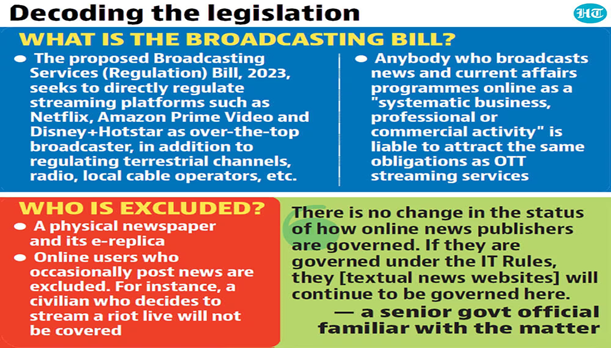A LICENCE RAJ FOR DIGITAL CONTENT CREATORS
Syllabus:
- GS 2 – Governance,
- GS 3 – Economic Development
Context
- The Indian government is introducing new regulations aimed at controlling digital content creators through the Broadcasting Regulation Bill, 2024.
- This move is seen as a response to the growing influence of digital media, especially in shaping political opinions.
- The bill proposes to regulate digital platforms under the Ministry of Information and Broadcasting (MIB), similar to traditional media regulations.
Source: www.hindustantimes.com
Significance of Digital Media
- Digital media has grown exponentially, providing platforms for independent content creators.
- Surveys indicate that a significant portion of the population consumes political content online, sometimes surpassing traditional media in reach.
- Platforms like YouTube, WhatsApp, and Facebook have become major sources of news and information.
- Citing CSD-Lokniti surveys, 29% of respondents consume political content on digital platforms every day.
Key Measures and Developments
- Broadcasting Regulation Bill, 2024:
- The bill proposes new regulations for digital content creators, requiring them to register with the Ministry of Information and Broadcasting (MIB).
- It grants the MIB new powers to regulate and block digital news media and online entertainment streaming apps.
- Creation of Regulatory Bodies:
- The bill creates the “Grievance Appellate Committees” (GACs), comprising officials from various ministries, to oversee the implementation of the new regulations.
- These committees have the power to hear appeals and enforce content takedown orders.
- Between January 28 and April 6, 2023, GACs issued 1,216 appeals and 1,089 secret orders to remove content.
- Impact on Content Creators:
- The regulations aim to control the spread of what the government deems “fake, false, and misleading” content.
- Content creators will face stricter scrutiny, potentially leading to a form of censorship that critics argue stifles freedom of expression.
- The bill’s broad definition of “content election” or “influence selection” has raised concerns about its potential misuse.
Impact on Digital Media
- Economic and Creative Freedom:
- The new regulations could hamper the economic prospects of digital content creators by imposing bureaucratic hurdles.
- The creative freedom that has fueled the growth of digital media might be curtailed, affecting the diversity of content available to audiences.
- Digital platforms face the risk of increased compliance costs and potential penalties.
- Political Implications:
- Digital media has been a platform for political dissent and alternative narratives, often challenging mainstream media.
- The new regulations could be seen as an attempt to control these narratives, aligning digital media more closely with government interests.
- The MIB’s enforcement of action on issues like internal security reflects political interests.
Broader Implications
- Comparative Analysis with Traditional Media:
- Traditional media in India is already subject to significant regulation and oversight by the government.
- Bringing digital media under similar control could level the playing field but might also reduce the vibrancy and spontaneity that characterize online content.
- International Perspective:
- Countries worldwide are grappling with the regulation of digital content, balancing between control and freedom.
- India’s approach could influence other democracies in how they manage the digital space, potentially setting a precedent for stricter controls globally.
Challenges and Future Directions
- Technological Integration:
- Implementing these regulations effectively will require advanced technological tools for monitoring and compliance.
- Leveraging data analytics and artificial intelligence could help in identifying and managing non-compliant content.
- Balancing Regulation and Freedom:
- The government needs to find a balance between necessary regulation to prevent misinformation and maintaining the freedom of expression.
- Policies should be transparent and include stakeholder input to avoid perceptions of arbitrary control.
- Capacity Building:
- Training programs for regulatory officials and content creators on the new regulations can ensure smooth implementation.
- International collaboration can help India adopt best practices in digital content regulation.
Detailed Insights from the Image
- Digital Media Usage and Influence:
- Surveys by CSDS-Lokniti reveal insights into voter preferences and digital media consumption.
- Digital media’s growing importance is highlighted, with 29% of respondents consuming political content on digital platforms.
- Content Control Concerns:
- The dominance of digital media challenges traditional television news.
- There is a concern about the control over digital content and the potential influence on political narratives.
- Government’s Strategy:
- The Union Government has sought to expand its control over digital content through various regulatory measures.
- The creation of the Grievance Appellate Committees and the new powers granted to the MIB are significant steps in this direction.
- Industry Criticism:
- Industry experts criticize the new regulations, citing potential threats to freedom of expression and the risk of creating a restrictive environment for digital content creators.
- There are concerns about the efficiency and transparency of the regulatory process.
- Political Weaponization:
- The regulations are seen as an attempt by the government to weaponize content control for political gains.
- This includes targeting content that is critical of the government and potentially influencing public opinion ahead of elections.
- Legal and Constitutional Challenges:
- The new regulations have faced legal challenges, with the Supreme Court intervening in some cases.
- The balance between regulation and constitutional rights to freedom of expression remains a contentious issue.
Conclusion
The introduction of the Broadcasting Regulation Bill, 2024, marks a significant shift in how digital content is managed in India. While the government’s intention to curb misinformation and ensure compliance is valid, the potential for overreach and stifling of creative freedom remains a concern. It is crucial to strike a balance that protects both the integrity of information and the rights of content creators.
Mains Question
Discuss the implications of the Broadcasting Regulation Bill, 2024, on digital content creators in India. How can the government balance regulation with freedom of expression in the digital space? (250 words)
Source: The Hindu




